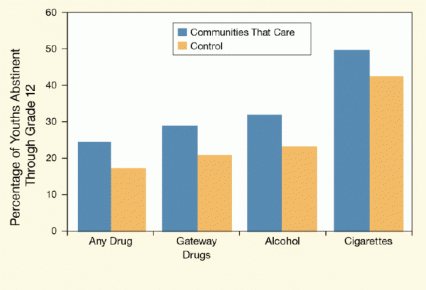The latest evaluation of a 24-town trial of Communities That Care (CTC) found that CTC-associated reductions in current substance use and delinquency, which had been observed when the children were in grades 8 and 10, were no longer evident in 12th grade. A benefit of CTC persisted, however: Although similar percentages of youths who had lived in CTC-using and comparison towns while in middle school reported that they had avoided those behaviors in 12th grade, higher percentages of those in CTC-using towns had done so in all previous grades as well.
Communities adopting CTC select from a roster of evidence-based prevention interventions those that target what school surveys of young people indicate are the most pertinent risk factors for the most pressing behavioral problems. CTC developer Dr. J. David Hawkins and colleagues at the University of Seattle in Washington initiated the trial in 2004, randomly assigning 12 towns to implement the program and 12 others to serve as control communities.
Altogether, more than 4,400 5th graders entered the trial, 55 percent of whom received CTC-sponsored interventions in their families, schools, and communities. In follow-up surveys when they were in 8th and 10th grade, students in the CTC communities reported lower rates of initiation of tobacco use, alcohol use, and delinquent activity than those in the comparison towns, as well as less current tobacco and alcohol use and binge drinking (see Prevention Program Averts Initiation of Alcohol and Tobacco Use and Prevention System Has Lasting Effects, Benefit Exceeds Costs). The researchers estimated that the program-associated reductions in problem behaviors would save the CTC towns more than $5 for every dollar invested in the program.
 Figure. In the Spring of 12th Grade, the Percentages of Youths Reporting That They Had Never Used Drugs, Alcohol, or Cigarettes Were Higher in the 12 CTC Towns Than in the 12 Non-CTC Towns
Figure. In the Spring of 12th Grade, the Percentages of Youths Reporting That They Had Never Used Drugs, Alcohol, or Cigarettes Were Higher in the 12 CTC Towns Than in the 12 Non-CTC Towns
- Text description of Figure
-
The figure shows a bar graph indicating the percentages of 12th graders living in CTC and control towns who, by the end of 12th grade, reported not having ever used a number of different substances. The vertical (y)-axis shows the percentage of youths abstinent through 12th grade and the horizontal (x)-axis the use of any drug, gateway drugs, alcohol, or cigarettes. As shown by blue bars for 12th graders from CTC towns and by orange bars for the 12th graders from control towns, a consistently higher percentage of those from CTC towns reported never having used the four substances assessed than among those in the control towns: 24, 29, 32, and 50 percent of the 12th graders in CTC reported not having used any drug, gateway drugs, alcohol, or cigarettes, respectively, while only 18, 21, 23, and 43 percent, respectively, of the 12th graders reported that level of abstinence.
More than 90 percent of the original student participants responded to the survey that forms the basis of the new evaluation, including 75 percent who were attending 12th grade and 25 percent who had left school. Those from the CTC communities were about 30 percent more likely than those in the control communities to have never used any substance—including alcohol, cigarettes, and marijuana—over the 8 years since the study began (see Figure). They also were almost 20 percent more likely to have never engaged in delinquent behavior. The survey results also disclosed, however, that the portions of participants who had used drugs, alcohol, or tobacco within the last year were similar in the CTC and control towns.
Dr. Hawkins comments that CTC continued to benefit youths through 12th grade, even though the CTC communities in this study focused on preventive interventions for youths in grades 6 through 9. He suggests that extending the interventions to target risk factors through the high school years could strengthen effects on substance use and delinquent behaviors on the cusp of adulthood.
This study was supported by NIH grants DA015183 and DA015183.
Source:
Hawkins, J.D.; Oesterle, S.; Brown, E.C. et al. Youth problem behaviors 8 years after implementing the Communities That Care prevention system: A community-randomized trial. JAMA Pediatrics 168(2):122-129. Abstract
